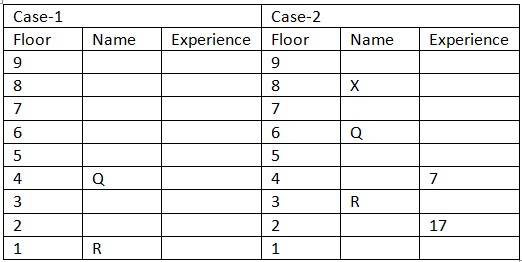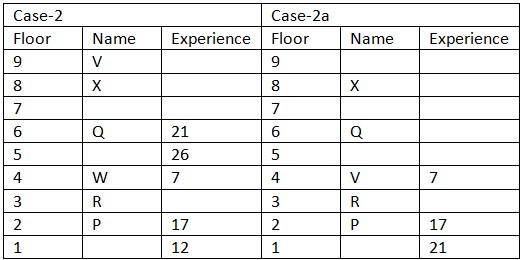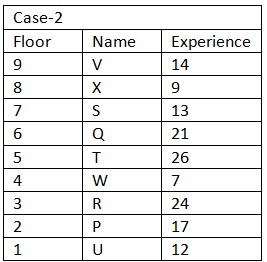Question
The number of persons living between S and the one whose
experience is 7 years is the same p? Study the following information carefully and answer the below questions. Nine persons namely – P, Q, R, S, T, U, V, W, and X live in a nine floored building marked 1 to 9 from bottom to top. Each person has different working experience viz.- 7, 9, 12, 13, 14, 17, 21, 24, and 26. All the information is not necessary in the same order. Note: The experience of the persons living on the adjacent floor is neither a common factor nor a common multiple. Q lives on an even number floor. R, who lives on any floor below floor number 4, lives three floors away from Q and doesn’t have experience of 12 years. W lives on any floor above the one whose experience is 12 years but not adjacent to Q’s floor. Neither Q nor R lives on the adjacent floor of X, who lives four floors away from the one whose experience is 7 years. V lives three floors above the one whose experience is 21 years. The number of persons living between Q and X is the same as the number of persons living below P, whose experience is 17 years. The number of persons living between V and the one whose experience is 26 years is one more than the number of persons living between the one whose experience is 12 years and W. Experience of X is neither 26 nor 14 years. The one whose experience is 14 years lives two floors away from S. The number of persons living between S and Q is the same as between S and the one whose experience is 9 years. W doesn’t live on the topmost floor. U has less experience than T.Solution
Q lives on an even number floor. R, who lives on any floor below floor number 4, lives three floors away from Q and doesn’t have experience of 12 years. That means, in case (2) Q lives on floor number 6, in case (1) Q lives on floor number 4. Neither Q nor R lives on the adjacent floor of X, who lives four floors away from the one whose experience is 7 years. The number of persons living between Q and X is the same as the number of persons living below P, whose experience is 17 years. That means, in case (2) X lives on floor number 8, case (1) is not valid. Based on the above given information we have:  Case (1) is not valid as the number of persons living between Q and X is the same as the number of persons living below P, whose experience is 17 years. Again, we have: V lives three floors above the one whose experience is 21 years. That means, in case (2) V lives on floor number 9, in case (2a) V lives on floor number 4. The number of persons living between V and the one whose experience is 26 years is one more than the number of persons living between the one whose experience is 12 years and W. The experience of X is neither 26 nor 14 years. W lives on any floor above the one whose experience is 12 years but not adjacent to Q’s floor. W doesn’t live on the topmost floor. That means, in case (2) the one whose experience is 12 years lives on floor number 1, case (2a) is not valid. Based on the above given information we have:
Case (1) is not valid as the number of persons living between Q and X is the same as the number of persons living below P, whose experience is 17 years. Again, we have: V lives three floors above the one whose experience is 21 years. That means, in case (2) V lives on floor number 9, in case (2a) V lives on floor number 4. The number of persons living between V and the one whose experience is 26 years is one more than the number of persons living between the one whose experience is 12 years and W. The experience of X is neither 26 nor 14 years. W lives on any floor above the one whose experience is 12 years but not adjacent to Q’s floor. W doesn’t live on the topmost floor. That means, in case (2) the one whose experience is 12 years lives on floor number 1, case (2a) is not valid. Based on the above given information we have:  Case (2a) is not valid as W lives on any floor above the one whose experience is 12 years but not adjacent to Q’s floor and W doesn’t live on the topmost floor. Again, we have: The one whose experience is 14 years lives two floors away from S. U has less experience than T. The number of persons living between S and Q is the same as between S and the one whose experience is 9 years. Since, persons whose experiences are in common multiple are not living on the adjacent floor. This, the experience of S is 13 years. Based on the above given information we have
Case (2a) is not valid as W lives on any floor above the one whose experience is 12 years but not adjacent to Q’s floor and W doesn’t live on the topmost floor. Again, we have: The one whose experience is 14 years lives two floors away from S. U has less experience than T. The number of persons living between S and Q is the same as between S and the one whose experience is 9 years. Since, persons whose experiences are in common multiple are not living on the adjacent floor. This, the experience of S is 13 years. Based on the above given information we have 
In these questions two sentences are given with blanks in them and you have to choose an appropriate word from the given options that can fill both the...
You are provided with a sentence with one word missing, denoted by a blank. You are presented with four options (A), (B), (C) and (D), identify which of...
Fill in the blanks by choosing the correct connector from the alternatives given below each sentence.
____ you have any doubt, please ask me....
While hiking the mountains of Nepal, a British Hiker irked a tea seller by bargaining for what she thought was steeply priced tea. At 150 Nepalese Rupee...
Educate your children and let them learn to live with ________.
(A) elevation (B) dignity (C) respect ...
Fill in the blanks using the correct tense of the verbs given in brackets and choose the right answer from among the options given below them.
Turning around a __________ ship is never easy.
(A) large
(B) small
(C) tiny
(D) huge
- Given below is a sentence with one blank. Below the sentence are given four words among which one word might fill the blank. If none of the words fill the ...
Despite the uninspiring weather, the city was ……….. with a youthful ………..
In the following sentences, two words are omitted. Choose the correct option that can fill the blanks both contextually and grammatically.
Th...
Relevant for Exams:


